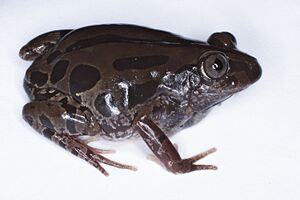Senegal running frog facts for kids
Quick facts for kids Senegal running frog |
|
|---|---|
 |
|
| Conservation status | |
| Scientific classification | |
 |
|
| Range map of K. senegalensis | |
| Synonyms | |
|
List
|
The Kassina senegalensis, also known as the Senegal running frog, is a type of frog. It lives in many parts of Africa. This frog is small and strong with big eyes. Its body is mostly greyish-black. It also has brown stripes and spots.
You can find these frogs in many places. They live in shrublands, grasslands, and wetlands. They can live high up, even at 2,000 meters (about 6,500 feet). They lay their eggs in water. The eggs are fertilized one by one. Senegal running frogs eat different kinds of arthropods. They also make special chemicals from their skin. This helps them avoid being eaten by other animals. Scientists believe there are many of these frogs. They are not in danger right now.
Contents
About the Senegal Running Frog
The Senegal running frog is a small, sturdy frog. Its eyes are large and stick out a bit. The head looks like a triangle with a rounded tip. Its skin is smooth.
These frogs are greyish-black. They have brown stripes and spots. These marks are on their ears and around their eyes. They are usually 35 to 40 millimeters (about 1.4 to 1.6 inches) long. Male frogs are a little smaller than females. Males have dark brown vocal sacs. These sacs can get much bigger when they call.
Frog eggs are about 3 millimeters (0.1 inches) wide. This includes the jelly-like layer around them. Baby frogs, called tadpoles, can be hard to identify. This is because they look different from each other. Tadpoles can grow up to 75 millimeters (about 3 inches) long. They have wide fins and humped backs.
Where They Live
The Kassina senegalensis lives in a large area of Africa. You can find them from Senegal in the west to Ethiopia and Somalia in the east. They also live as far south as South Africa.
They live in many different places. These include savannas (both wet and dry). They also live in montane grasslands and shrublands and wetlands. You can even find them in places made by people. These include pastures and canals. They can live at heights up to 2,000 meters (about 6,500 feet).
Frog Behavior and Life Cycle
Reproduction and Life Cycle
Senegal running frogs can breed in water that is temporary or always there. They usually choose water that lasts a long time. This is because their babies take a while to grow. Male frogs call to attract females.
The male frog holds onto the female. They stay about 2 millimeters (0.08 inches) apart. The female lays eggs one by one. The male fertilizes them. The pair moves often, laying 1 to 15 eggs at each spot. The eggs are laid 1 to 6 centimeters (0.4 to 2.4 inches) deep. They quickly sink to the bottom. A female can lay about 600 eggs in total. The eggs hatch after about six days.
If there are fish in the breeding ponds, the frogs breed for a shorter time. Many other frog types avoid breeding where fish are. If a type of catfish, Clarias gariepinus, is put into the water, the frogs stop breeding right away. It takes 50 to 60 days for the tadpoles to change into frogs. This process is called metamorphosis.
What They Eat
Scientists studied K. senegalensis frogs in Cameroon. They found these frogs eat many different things. They mainly eat Orthoptera insects (like grasshoppers), which make up 36% of their diet. They also eat ants (24%) and spiders (10%). They do not seem to prefer a certain size of prey.
Skin Protection
Senegal running frogs have a special defense. They release a chemical called Kassinakinin S from their skin. This chemical can cause swelling and pain in animals that try to eat them. This helps other protective chemicals get into the predator's body.
Protecting the Frogs
The International Union for the Conservation of Nature (IUCN) has looked at K. senegalensis. They say it is a least-concern species. This means it is not in danger. They have a wide range and can live in many different places. It is not clear if their large population has changed much recently.
In some local areas, these frogs might be affected if their homes are badly damaged. People sometimes trade them as pets. However, this trade is not big enough to cause special concern. These frogs also live in many protected areas across their range.


